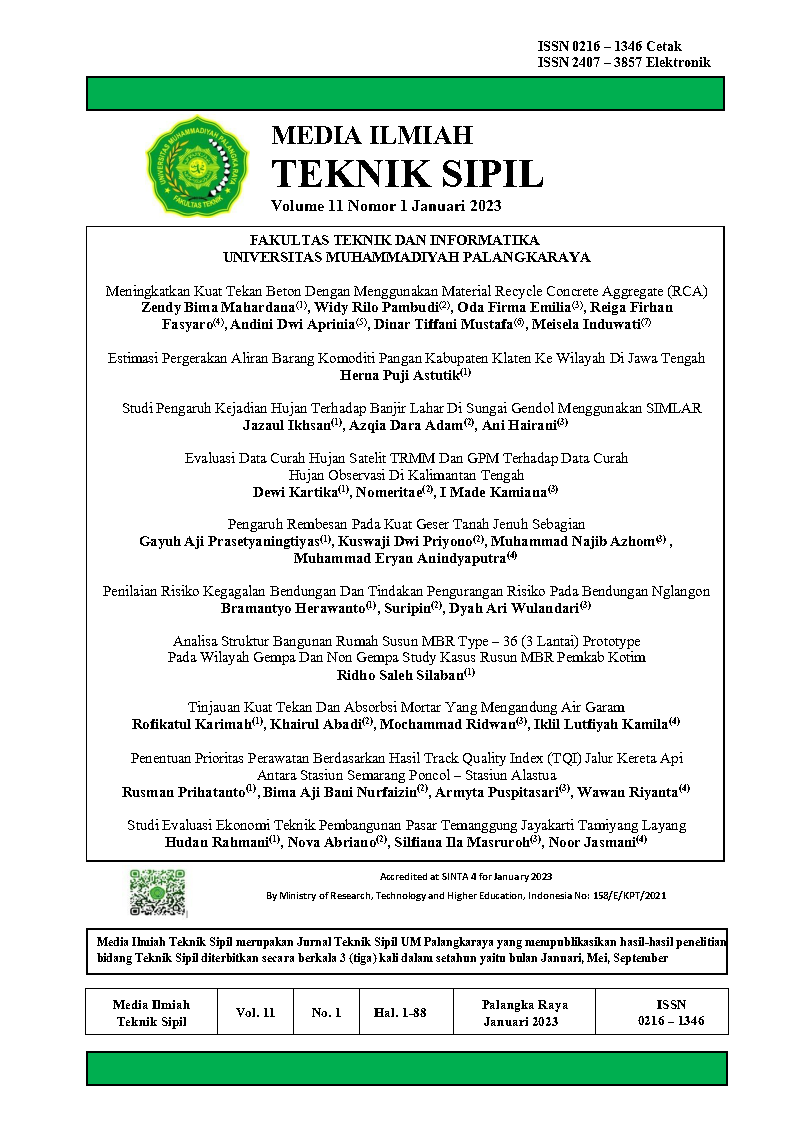Meningkatkan Kuat Tekan Beton Dengan Menggunakan Material Recycle Concrete Aggregate (RCA) Increase Concrete Compressive Strength By Using Recycle Concrete Aggregate (RCA) Material
Main Article Content
Abstract
Concrete is part of the building structure used in various large-scale infrastructure projects. concrete composed mixture of cement, fine aggregate, coarse aggregate, and water. Concrete able to withstand compressive forces optimally, concrete also has a smaller tensile strength than steel structures. excessive use corals causes availability materials to be depleted, is necessary to innovate continuously with use RCA. RCA is waste concrete recycled into aggregates can be reused to make concrete. The purpose is to determine the compressive strength value in concrete by replacing coarse aggregates from concrete waste measuring 19.05 mm (sieve no. 3/4). The method used experimental method by making a test object form of a cylinder with tests including testing of moisture content, sludge content, wear, and compressive strength concrete. The results obtained a normal concrete slump value 11 cm. While the concrete waste 4.4 cm. From the results were obtained according to the plan where in normal concrete was worth 17,444 Mpa and in concrete with the use of coarse aggregates from concrete waste showed a compressive strength result of 24,653 Mpa. So that shows the use waste concrete material is able to produce good concrete quality with a higher compressive strength value than normal concrete
Downloads
Article Details

This work is licensed under a Creative Commons Attribution-ShareAlike 4.0 International License.
All rights reserved. This publication may be reproduced, stored in a retrieval system, or transmitted in any form or by any means, electronic, mechanical, photocopying, recording.
References
Abbass, W., Khan, M. I., & Mourad, S. (2018). Evaluation of mechanical properties of steel fiber reinforced concrete with different strengths of concrete. Construction and Building Materials, 168, 556–569. https://doi.org/10.1016/j.conbuildmat.2018.02.164
Abreu, V., Evangelista, L., & de Brito, J. (2018). The effect of multi-recycling on the mechanical performance of coarse recycled aggregates concrete. Construction and Building Materials, 188, 480–489. https://doi.org/10.1016/j.conbuildmat.2018.07.178
Akhtar, A., & Sarmah, A. K. (2018). Construction and demolition waste generation and properties of recycled aggregate concrete: A global perspective. Journal of Cleaner Production, 186, 262–281. https://doi.org/10.1016/j.jclepro.2018.03.085
ASTM C 566-97. (2004). Astm C 566-97. Standard Test Method for Total Evaporable Moisture Content of Aggregate by Drying, i(Reapproved), 3.
ASTM C39/C39M. (2003). Standard Test Method for Compressive Strength of Cylindrical Concrete Specimens 1. ASTM Standard Book, i(March), 1–5.
Badan Standardisasi Nasional. (1990a). SNI 03-1972-1990 : Metode Pengujian Slump Beton. Badan Standar Nasional Indonesia, 1(ICS 91.100.30), 1–12.
Badan Standardisasi Nasional. (1990b). SNI 03-1974-1990 Metode Pengujian Kuat Tekan Beton. Badan Standardisasi Nasional Indonesia.
Badan Standardisasi Nasional. (2002). Tata Cara Perhitungan Struktur Beton Untuk Bangunan Gedung. SNI 03-2847-2002. Bandung: Badan Standardisasi Nasional, 251.
Dipohusodo, I. (1999). Struktu Beton Bertulang SK. SNI T-15-1991-03. 1–527.
Dumyati, A., & Manalu, D. F. (2015). Analisis Penggunaan Pasir Pantai Sampur Sebagai Agregat Halus Terhadap Kuat Tekan Beton. Jurnal Fropil, 3(1), 1–13. https://www.journal.ubb.ac.id/index.php/fropil/article/view/1203
Huseien, G. F., & Shah, K. W. (2020). Durability and life cycle evaluation of self-compacting concrete containing fly ash as GBFS replacement with alkali activation. Construction and Building Materials, 235, 117458. https://doi.org/10.1016/j.conbuildmat.2019.117458
Mahendra, Y. I, Gardjito. E, Ridwan. A, W. H. (2021). Meningkatkan Kuat Tekan Beton Fc’ 16,60 Mpa Menggunakan Fly Ash Dan Arang Batok Kelapa. Jurnal Manajemen Teknologi & Teknik Sipil, 4, 1–13. https://doi.org/10.1016/j.conbuildmat.2020.121
Maryanto, M., Winarto, S., & Krisnawati, L. D. (2018). Studi Eksperimental Pengaruh Penambahan Limbah Kuningan Terhadap Kuat tekan Beton Mutu K-225. Jurnal Manajemen Teknologi & Teknik Sipil, 1(1), 76–90. https://doi.org/10.30737/jurmateks.v1i1.142
Mi, R., Pan, G., Liew, K. M., & Kuang, T. (2020). Utilizing recycled aggregate concrete in sustainable construction for a required compressive strength ratio. Journal of Cleaner Production, 276, 124249. https://doi.org/10.1016/j.jclepro.2020.124249
Nedeljković, M., Visser, J., Šavija, B., Valcke, S., & Schlangen, E. (2021). Use of fine recycled concrete aggregates in concrete: A critical review. Journal of Building Engineering, 38(May 2020). https://doi.org/10.1016/j.jobe.2021.102196
Nurain Izzati, M. Y., Suraya Hani, A., Shahiron, S., Sallehuddin Shah, A., Mohamad Hairi, O., Zalipah, J., Noor Azlina, A. H., Mohamad Nor Akasyah, W. A., & Nurul Amirah, K. (2019). Strength and water absorption properties of lightweight concrete brick. IOP Conference Series: Materials Science and Engineering, 513(1). https://doi.org/10.1088/1757-899X/513/1/012005
Pane, F. P., Tanudjaja, H., & Windah, R. S. (2015). Pengujian kuat tarik lentur beton dengan variasi kuat tekan beton. Jurnal Sipil Statik, 3(5), 313–321.
Qin, L., Gao, X., & Chen, T. (2018). Recycling of raw rice husk to manufacture magnesium oxysulfate cement based lightweight building materials. Journal of Cleaner Production, 191, 220–232. https://doi.org/10.1016/j.jclepro.2018.04.238
Santos, S., da Silva, P. R., & de Brito, J. (2019). Self-compacting concrete with recycled aggregates – A literature review. Journal of Building Engineering, 22(January), 349–371. https://doi.org/10.1016/j.jobe.2019.01.001
Singh, N. B., & Middendorf, B. (2020). Geopolymers as an alternative to Portland cement: An overview. Construction and Building Materials, 237, 117455. https://doi.org/10.1016/j.conbuildmat.2019.117455
SNI 03-2834-2000. (2000). SNI 03-2834-2000: Tata cara pembuatan rencana campuran beton normal. Sni 03-2834-2000, 1–34.
Tamayo, P., Pacheco, J., Thomas, C., de Brito, J., & Rico, J. (2020). Mechanical and durability properties of concrete with coarse recycled aggregate produced with electric arc furnace slag concrete. Applied Sciences (Switzerland), 10(1). https://doi.org/10.3390/app10010216
Yansiku, S. I. (2018). Perilaku Kekuatan Beton dengan Partikel Gelas dan Karet Ban Bekas Sebagai Pengganti Pasir Alam. Jurnal Teknik Sipil Dan Lingkungan, 3(1), 1–10. https://doi.org/10.29244/jsil.3.1.1-10
Zhu, P., Hao, Y., Liu, H., Wei, D., Liu, S., & Gu, L. (2019). Durability evaluation of three generations of 100% repeatedly recycled coarse aggregate concrete. Construction and Building Materials, 210, 442–450. https://doi.org/10.1016/j.conbuildmat.2019.03.203
